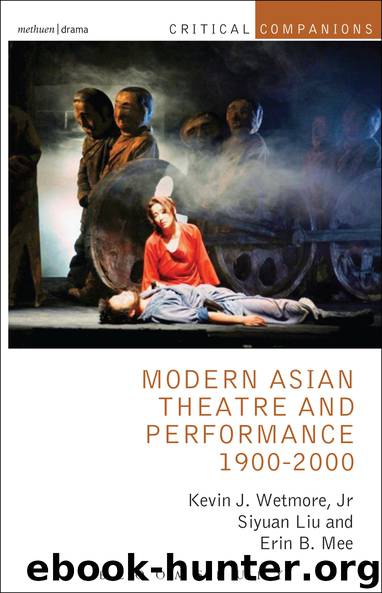Modern Asian Theatre and Performance 1900-2000 by Wetmore Jr. Kevin J.; Liu Siyuan; Mee Erin B

Author:Wetmore, Jr., Kevin J.; Liu, Siyuan; Mee, Erin B. [Неизв.]
Language: eng
Format: epub
Publisher: Bloomsbury Publishing
Shinp’agŭk
After Yi’s early experiments at the Wŏn’gak-sa, Shinp’agŭk (new school drama) was imported from Japan in 1911. As the name suggests, it was the Korean version of Japanese shinpa. The first shinpagŭk company in Seoul was the Revolutionary Troupe (Hyŏkshindan), founded by actor and producer Im Sŏng-gu (1887–1921), formed in 1911 with their first production, Divine Punishment for Lack of Filial Piety (Purhyo Ch’ŏnbŏl). Shinp’a dramas were melodramatic, sentimental, tear-jerkers with improvised dialogue. Initially, the quality of plays and performances was poor, as Hyŏkshindan, which lasted as a company until 1920, and those that followed were relying on third-rate Japanese companies that toured Korea as their model. Experimentation and experience, however, raised the quality of performances.
Shinp’agŭk took a step forward with the founding in 1922 of the Earth Moon Group (Towolhoe) by Pak Sŭng-hŭi (1901–64), a director, producer and shinp’a playwright. Pak was a university student in Tokyo who returned to Seoul and led the Towolhoe for over twenty years. Pak was a theatre reformer, the first to use fully written scripts instead of improvisation and insisting upon extensive rehearsals. He wrote over two hundred plays, most of which have not survived, lost during the Korean War (1950–3).
Shinp’a plays fell into three categories: military history plays in which Korean soldiers fought to defend the nation (serving as a counterpoint to Japanese propaganda), criminal plays in which a heroic policeman finds and captures a notorious criminal (demonstrating virtue and the dangers of vice), and domestic family plays dealing with conflicts between generations (fathers and sons) and genders (husbands and wives or lovers). Sentimentality ruled, as did a simple morality: virtue, love and self-sacrifice were rewarded, while vice was inevitably punished. Suffering was a big theme in shinp’a, partly for its melodramatic qualities, and also because the depiction of melodramatic suffering became a means around Japanese censorship by showing misery and anguish in seeming domestic or criminal situations, with the implication that the Japanese occupation was the reason why the characters were suffering. Shinp’a thus also became a drama of resistance.
By the mid-1920s, however, shinp’a was in decline, replaced by the development of another modern theatre, also derived from and imposed by the Japanese: shingŭk, the Korean version of Japanese shingeki. This is not to suggest shinp’a disappeared, replaced by shingŭk. The Towolhoe lasted until 1946 with a faithful, albeit small, audience. Likewise, some of Pak’s plays are still performed today. In the larger theatrical world, however, shinp’a ceased to develop as a form and was eclipsed by shingŭk.
Download
This site does not store any files on its server. We only index and link to content provided by other sites. Please contact the content providers to delete copyright contents if any and email us, we'll remove relevant links or contents immediately.
| Coloring Books for Grown-Ups | Humor |
| Movies | Performing Arts |
| Pop Culture | Puzzles & Games |
| Radio | Sheet Music & Scores |
| Television | Trivia & Fun Facts |
0805097341 (N) by Andrew Dickson(672)
The World Only Spins Forward by Isaac Butler(666)
Chaos Imagined by Martin Meisel(617)
Stella Adler on Ibsen, Strindberg, and Chekhov by Stella Adler(592)
Real Life Drama by Wendy Smith(396)
Philosophy and Theatre by Stern Tom(385)
The Soviet Theater by Laurence Senelick(365)
Poetics of History by Lacoue-Labarthe Philippe;Fort Jeff;(357)
Brecht in Practice by Barnett David(356)
Charles Dickens and the Great Theatre of the World by Simon Callow(352)
The Crucible by Arthur Miller(334)
The Columbia Anthology of Modern Chinese Drama by Xiaomei Chen(320)
Virgil Thomson by Virgil Thomson(300)
Shakespeare and the Countess by Chris Laoutaris(297)
The Definitive Shakespeare Companion by Joseph Rosenblum(286)
The Videofag Book by Jordan Tannahill & Jordan Tannahill(258)
A Short History of English Renaissance Drama by Helen Hackett(238)
A History of Leadville Theater: Opera Houses, Variety Acts and Burlesque Shows by Scanlon Gretchen(232)
Showtime at the Apollo by Ted Fox(230)
